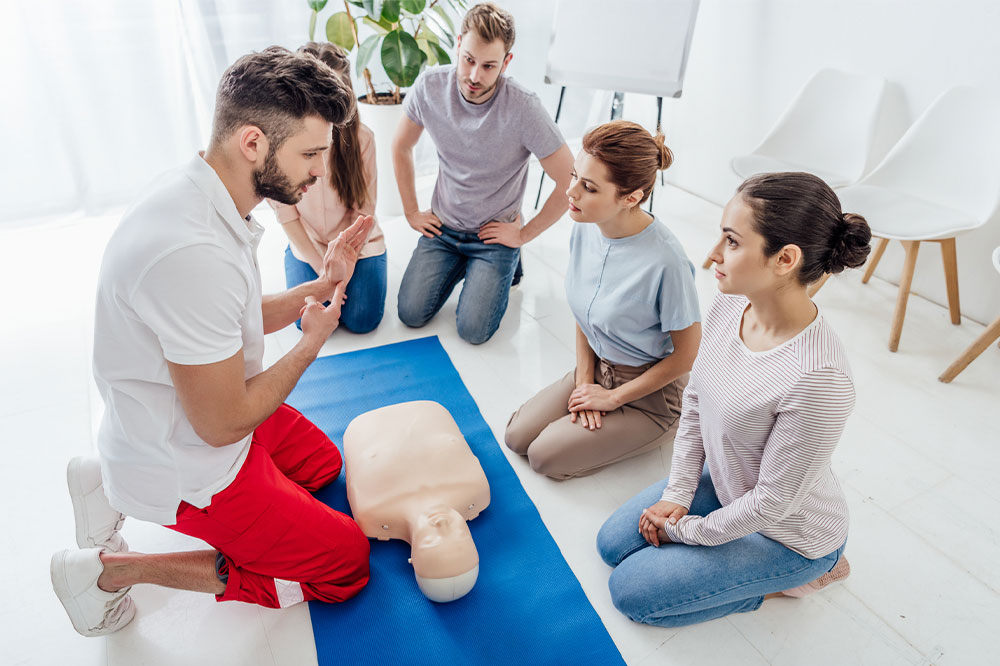
Key elements of a first aid training program
First aid assists sick or injured people before they get professional care from an expert. It helps maintain an individual’s condition and keeps them stable until taken to a doctor. Proper first aid can save lives and help with faster recovery during anaphylaxis shocks, bleeding, burns, choking, electric shocks, or heart attacks. Read on to learn the importance of first aid and the topics covered in a first aid training program.
Purpose of first aid training
Many people do not think about acquiring first aid skills until they face a sudden illness or injury and find themselves not knowing what to do. They panic or freeze in an emergency and do not respond correctly. Proper first aid training prepares individuals to understand the situation quickly, ask basic questions, and follow emergency procedures without panicking.
The inability to gauge an emergency or a lack of awareness about how and when to move an injured person can cause severe health damage and even lead to death. The main principles of first aid are to save a person’s life, relieve pain, help in recovery, and protect the unconscious.
Elements of a first aid course
A first aid course teaches valuable skills to deal with scenarios like bleeding, burns, choking, poisoning, and respiratory problems. The major components of a first aid training course are:
Emergency response
Among the first things candidates learn in a first aid training program is how to respond to an emergency. The course teaches people to assess the situation, approach the injured or sick person, and explain the problem to the first responders. Random or rushed first aid decisions can be dangerous. Proper training teaches individuals not to panic and helps them see the situation clearly and rationally. It also teaches one how to gauge severe emergencies where it is best not to do anything and call 911 immediately.
Cardiopulmonary resuscitation (CPR)
Schools teach students how to perform CPR, but just basic knowledge may not be adequate in an emergency. A first aid training course teaches people the correct way of performing CPR, the number of compressions, the duration of the procedure, and when to stop.
Automated external defibrillators (AEDs)
Most states have made it mandatory for schools, offices, businesses, and residences to have AEDs on their premises. These healthcare devices use electrical impulses to re-establish the heart’s rhythm. An AED is used with CPR in the event of a cardiac arrest to increase the chance of survival. In a first aid course, candidates learn to use the device correctly without panicking.
Wound care
A first aid training program teaches people how to minimize or stop bleeding and disinfect and dress different wounds. One could be dealing with simple cuts in the home or workplace or bigger trauma or burn injuries. The treatment procedures may vary depending on the wound’s location and size. Knowing how to stop bleeding is an essential first aid skill that can save lives in the event of severe bleeding.
Choking and breathing difficulties
More than 4,000 people die yearly from choking, including infants and adults. First aid can save people who accidentally choke on food, suffer from an anaphylactic shock due to an allergy, or have respiratory distress due to asthma. The training program teaches people to help patients so that they may breathe again.
Poisoning
Insect bites, stings, toxic plants, and chemicals can cause poisoning. Identifying the problem immediately and administering first aid can help prevent serious health damage and calm the patient until they reach a hospital. A first aid course teaches individuals to identify cases of poisoning by observing the symptoms or the body’s reaction to the poison.
Fractures and injuries
A slip or a fall may cause a sprain or fracture that can be extremely painful. First aid training programs teach candidates to make slings, so the affected body part is immobilized and does not swell up. They also teach people how to move the patient carefully without dislodging the bone. The fracture could occur in any body part, such as the hands, legs, neck, spine, or joints.
Importance of first aid kits
A well-equipped first aid kit in the home, workplace, or vehicle can help one instantly treat minor cuts or bruises, stop excessive bleeding, prevent fevers, and reduce pain. Individuals can gather first aid items and create a customized kit or purchase one from the store. The critical first aid kit items include:
For dressing:
Adhesive bandages
Cotton wool
Plasters in different sizes
Sterile gauze dressings
Sterile eye dressings
Rolled crepe bandages
Disposable hospital-grade masks and gloves
Cleansing wipes
Hospital-grade sanitizers
Distilled water
Hydrogen peroxide
Tools:
Scissors
Tweezers
Digital thermometers
Safety pins
Blood pressure cuff
Other items:
Pain relief spray
Glucose
ORS solutions
Sting or rash creams
Eyewash
The farther a person lives from a healthcare institution, the better stocked their first aid kits should be. The kit should be stored in a cool, dry place and should be easily accessible.




